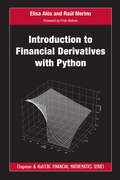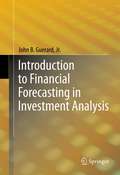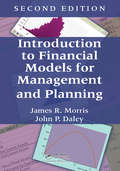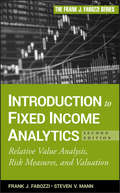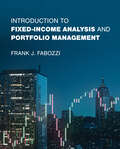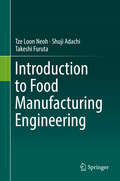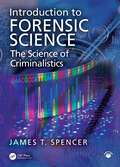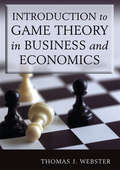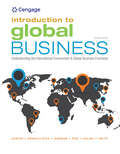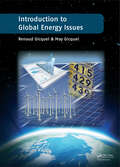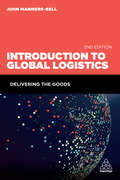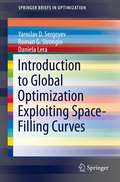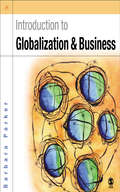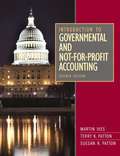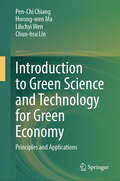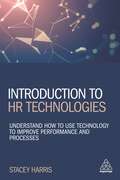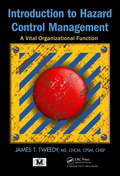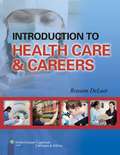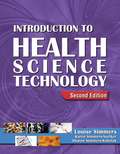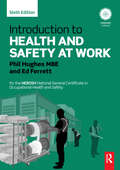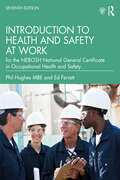- Table View
- List View
Introduction to Financial Derivatives with Python (Chapman and Hall/CRC Financial Mathematics Series)
by Elisa Alòs Raúl MerinoIntroduction to Financial Derivatives with Python is an ideal textbook for an undergraduate course on derivatives, whether on a finance, economics, or financial mathematics programme. As well as covering all of the essential topics one would expect to be covered, the book also includes the basis of the numerical techniques most used in the financial industry, and their implementation in Python. Features Connected to a Github repository with the codes in the book. The repository can be accessed at https://bit.ly/3bllnuf Suitable for undergraduate students, as well as anyone who wants a gentle introduction to the principles of quantitative finance No pre-requisites required for programming or advanced mathematics beyond basic calculus
Introduction to Financial Forecasting in Investment Analysis
by John B. Guerard Jr.Forecasting--the art and science of predicting future outcomes--has become a crucial skill in business and economic analysis. This volume introduces the reader to the tools, methods, and techniques of forecasting, specifically as they apply to financial and investing decisions. With an emphasis on "earnings per share" (eps), the author presents a data-oriented text on financial forecasting, understanding financial data, assessing firm financial strategies (such as share buybacks and R&D spending), creating efficient portfolios, and hedging stock portfolios with financial futures. The opening chapters explain how to understand economic fluctuations and how the stock market leads the general economic trend; introduce the concept of portfolio construction and how movements in the economy influence stock price movements; and introduce the reader to the forecasting process, including exponential smoothing and time series model estimations. Subsequent chapters examine the composite index of leading economic indicators (LEI); review financial statement analysis and mean-variance efficient portfolios; and assess the effectiveness of analysts' earnings forecasts. Using data from such firms as Intel, General Electric, and Hitachi, Guerard demonstrates how forecasting tools can be applied to understand the business cycle, evaluate market risk, and demonstrate the impact of global stock selection modeling and portfolio construction.
Introduction to Financial Models for Management and Planning
by James R. Morris John P. DaleyA properly structured financial model can provide decision makers with a powerful planning tool that helps them identify the consequences of their decisions before they are put into practice. Introduction to Financial Models for Management and Planning, Second Edition enables professionals and students to learn how to develop and use computer-based models for financial planning. This volume provides critical tools for the financial toolbox, then shows how to use them tools to build successful models.
Introduction to Financial Ratios and Financial Statement Analysis
by William J. Bruns Jr.Introduces and describes meaning and uses for financial ratios to assess profitability, activity, solvency and leverage, and returns to shareholders.
Introduction to Fixed Income Analytics
by Frank J. Fabozzi Steven V. MannA comprehensive introduction to the key concepts of fixed income analyticsThe First Edition of Introduction to Fixed Income Analytics skillfully covered the fundamentals of this discipline and was the first book to feature Bloomberg screens in examples and illustrations. Since publication over eight years ago, the markets have experienced cathartic change.That's why authors Frank Fabozzi and Steven Mann have returned with a fully updated Second Edition. This reliable resource reflects current economic conditions, and offers additional chapters on relative value analysis, value-at-risk measures and information on instruments like TIPS (treasury inflation protected securities).Offers insights into value-at-risk, relative value measures, convertible bond analysis, and much moreIncludes updated charts and descriptions using Bloomberg screens Covers important analytical concepts used by portfolio managersUnderstanding fixed-income analytics is essential in today's dynamic financial environment. The Second Edition of Introduction to Fixed Income Analytics will help you build a solid foundation in this field.
Introduction to Fixed-Income Analysis and Portfolio Management
by Frank J. FabozziA concise but comprehensive introduction to fixed income analysis for undergraduate and graduate students.Offering more concise and less technical coverage of the material featured in the classic text Bond Markets, Analysis, and Strategies, this streamlined book is rightsized for a one-semester fixed-income course. In accessible terms, Frank Fabozzi describes the sectors of the fixed-income market, details how to value fixed-income instruments, and shows how to measure interest rate risk and how to manage a fixed income portfolio. Key concepts are illustrated with extensive examples and exercises, and end-of-chapter questions invite further research. The result is an incisive but approachable introduction to fixed-income analysis for undergraduate finance and business students. Comprehensive coverage of fixed-income marketsEasy-to-understand framing of mathematical concepts accommodates a wide readership with varying levels of mathematical expertise Extensive illustrations and examples animate analytical chaptersWritten by an expert with deep experience in the asset management industry and the classroomPragmatic modular structuring of content enables adaptability to different curricula Instructor resources available
Introduction to Food Manufacturing Engineering
by Tze Loon Neoh Shuji Adachi Takeshi FurutaThis book provides basic food engineering knowledge for beginners. The discipline of food processing conforms with actual food manufacturing flows and thus is readily comprehensible, although food engineering has great diversity as the common principles of operations for most food manufacturing processes are covered. This volume therefore endeavors to initially embody food manufacturing flows and pays careful attention to quantitatively detailing and explaining the manufacturing operations involved from an engineering point of view. Because this book is intended to be a very basic introductory text for food engineering, it introduces a variety of foods and food ingredients with which the intended readership is familiar to explain comprehensively the fundamental unit operations through the manufacturing flows. Various real foods and food ingredients are used to explain the principles of food engineering so that students of food science, technology, and engineering courses will be able to better grasp the basic concepts. The book includes many exercises for learning how to draw proper graphs and how to deal with mathematical formulas and numerical values. Readers can learn common principles, which are easily applicable to other fields such as pharmaceuticals and biotechnology, through the many examples that are provided.
Introduction to Forensic Science: The Science of Criminalistics
by James T. SpencerIntroduction to Forensic Science: The Science of Criminalistics is a textbook that takes a unique and holistic approach to forensic science. This book focuses on exploring the underlying scientific concepts as presented at the introductory college and senior high school levels. Chapters introduce readers to each of the important areas of forensic science, grouping chapters together by discipline and following a logical progression and flow between chapters. This systematically allows students to understand the fundamental scientific concepts, recognize their various applications to the law and investigations, and discern how each topic fits broadly within the context of forensic science.The writing is accessible throughout, maintaining students’ interest – including both science and non-science majors – while inspiring them to learn more about the field. Concepts are demonstrated with numerous case studies and full-color illustrations that serve to emphasize the important ideas and issues related to a particular topic. This approach underscores scientific understanding, allowing the student to go beyond simple rote learning to develop deeper insights into the field, regardless of their scientific background. This book has been extensively classroom-tested to provide the most comprehensive and up-to-date survey of various forensic disciplines and the current state of the science, policies, and best practices. Key features: Presents a wholly new, fresh approach to addressing a broad survey of techniques and evidentiary analyses in the field of forensic science. All concepts – and the underpinnings of forensic practice – are explained in simple terms, using understandable analogies and illustrations to further clarify concepts. Introduces topics that other introductory texts fail to address, including serology, behavioral science, forensic medicine and anthropology, forensic ecology, palynology, zoology, video analysis, AI/computer forensics, and forensic engineering. Highly illustrated with over 1,000 full-color photographs, drawings, and diagrams to further highlight key concepts. Suitable for both high school senior-level instruction and two- and four-year university courses for majors, non-majors, and criminal justice students enrolled in introductory forensic science classes. Support Materials – including an Instructor’s Manual with test bank and chapter PowerPoint lecture slides – are available to professors with qualified course adoption.
Introduction to Game Theory in Business and Economics
by Thomas J. WebsterGame theory is the study of strategic behavior in situations in which the decision makers are aware of the interdependence of their actions. This innovative textbook introduces students to the most basic principles of game theory - move and countermove - with an emphasis on real-world business and economic applications. Students with a background in principles of economics and business mathematics can readily understand most of the material.Demonstration problems in each chapter are designed to enhance the student's understanding of the concepts presented in the text. Many chapters include non-technical applications designed to further the student's intuitive understanding of strategic behavior. Case studies help underscore the usefulness of game theory for analyzing real-world situations. Each chapter concludes with a review and questions and exercises. An online Instructor's Manual with test bank is available to professors who adopt the text.
Introduction to Global Business: Understanding the International Environment and Global Business Functions
by Leonard Bierman James W. Kolari L. Murphy Smith Antonio Arreola-Risa Julian E. Gaspar Richard T. HiseThe global business environment is rapidly changing due to shifts in geopolitical alliances, active support of international institutions in promoting market-oriented economic reforms, and advances in the development and use of information technology. INTRODUCTION TO GLOBAL BUSINESS, 2e addresses these challenges by providing a comprehensive analysis of the global business environment and lays the foundation for the functional tools used to better prepare students for a global business landscape. <P><P>The text flows smoothly and clearly from concept to application, asking your students to apply their learning to real-world personal and professional applications. The specialized author team introduces globalization through unparalleled scholarship and a world-view presentation of the fundamental pillars of the global business environment -- culture, ethics, economics, and information technology. Ensure that your students understand the procedures and concepts they need to know with MindTap for INTRODUCTION TO GLOBAL BUSINESS. MindTapTM, an online course management and learning system, combines the best of current technology to save time in planning and managing your course and assignments.
Introduction to Global Energy Issues
by Renaud Gicquel May GicquelFrom the discovery of fire to that of the atom, the development of human societies has largely been based on the conquest of energy. In all countries, energy has gradually become one of the key factors of social and economic development, as well as capital, labor and natural resources, and now no one can do without it. After decades of cheap energy
Introduction to Global Logistics: Delivering the Goods
by John Manners-BellIntroduction to Global Logistics offers a step-by-step guide to global logistics. Covering the breadth of logistics, this highly accessible text covers everything you need to know and is illustrated by engaging case studies of market leaders.In this comprehensive book John Manners-Bell provides an in depth definition, description and exploration of the strategic principles and practices in transportation modes and supply chain verticals, including: freight forwarding, contract logistics, shipping, road freight, air cargo and express. The book also examines major sectors, including Automotive, Chemical, Pharmaceutical, Retail, Consumer, and High Tech.Introduction to Global Logistics offers a detailed examination of key topics, including: how the logistics industry has developed, how it is influenced by macro-economic factors and demand-side trends, what the risks are to the industry, and how it will develop over the coming years. It examines important trends and developments that are shaping the industry, including 3D printing, megacities, and post-harvest food losses.
Introduction to Global Optimization Exploiting Space-Filling Curves
by Yaroslav D. Sergeyev Daniela Lera Roman G. StronginIntroduction to Global Optimization Exploiting Space-Filling Curves provides an overview of classical and new results pertaining to the usage of space-filling curves in global optimization. The authors look at a family of derivative-free numerical algorithms applying space-filling curves to reduce the dimensionality of the global optimization problem; along with a number of unconventional ideas, such as adaptive strategies for estimating Lipschitz constant, balancing global and local information to accelerate the search. Convergence conditions of the described algorithms are studied in depth and theoretical considerations are illustrated through numerical examples. This work also contains a code for implementing space-filling curves that can be used for constructing new global optimization algorithms. Basic ideas from this text can be applied to a number of problems including problems with multiextremal and partially defined constraints and non-redundant parallel computations can be organized. Professors, students, researchers, engineers, and other professionals in the fields of pure mathematics, nonlinear sciences studying fractals, operations research, management science, industrial and applied mathematics, computer science, engineering, economics, and the environmental sciences will find this title useful .
Introduction to Global Strategy, Module Note
by Jordan SiegelExamines when it is profitable for a company to position part or all of its activity set across national borders and how a cross-border business is successfully designed and managed.
Introduction to Global Sustainable Management
by Colin CombeAt a time when the effects of climate change are becoming all too real for ordinary citizens around the world, this essential textbook offers insight into how managers can shape and influence the development of sustainability practices as a means of tackling some of the most pressing social, economic, and environmental challenges. Featuring a distinctly international array of case studies and examples, as well as learning outcomes, definitions, questions, tasks and further reading, Introduction to Global Sustainable Management provides readers with a valuable understanding of how sustainable management practices can be implemented in different industry sectors across the globe. Suitable for upper-level undergraduate and postgraduate students of sustainable management-related courses. A Tutor’s Guide, PowerPoint slides and selected SAGE Business Cases are available to instructors via the companion website. Colin Combe is a senior lecturer in strategic management at Glasgow Caledonian University, UK.
Introduction to Global Sustainable Management
by Colin CombeAt a time when the effects of climate change are becoming all too real for ordinary citizens around the world, this essential textbook offers insight into how managers can shape and influence the development of sustainability practices as a means of tackling some of the most pressing social, economic, and environmental challenges. Featuring a distinctly international array of case studies and examples, as well as learning outcomes, definitions, questions, tasks and further reading, Introduction to Global Sustainable Management provides readers with a valuable understanding of how sustainable management practices can be implemented in different industry sectors across the globe. Suitable for upper-level undergraduate and postgraduate students of sustainable management-related courses. A Tutor’s Guide, PowerPoint slides and selected SAGE Business Cases are available to instructors via the companion website. Colin Combe is a senior lecturer in strategic management at Glasgow Caledonian University, UK.
Introduction to Globalization and Business: Relationships and Responsibilities
by Dr Barbara ParkerWhat is globalization? How have the world economies changed in recent years? What impact do these changes have on business and management practice? Through creative use of examples, case studies and exercises from organizations worldwide, this book demonstrates the many levels at which globalization impacts on contemporary businesses, society and organizations and elucidates the ways in which different globalization trends and factors interrelate. Focusing on an integrated approach to understanding the effects of global trends such as new technologies, new markets, and cultural and political changes, the book enables students to understand the wider implications of globalization and apply this to their study and comprehension of contemporary business and management. Each chapter: - opens with a short and current case which introduces the key concepts covered in that chapter - provides an overview of chapter objectives to allow the student to navigate easily - illustrates the chapter concepts with useful boxed examples - concludes with a review of the key chapter concepts learnt - provides a series of review and discussion questions - offers 'Global Enterprise Project' assignments for applying course concepts to the same company - gives up-to-date references from many sources to direct student's further reading. Students can access the companion website which includes additional material in support of each chapter of the book by clicking on the `companion website' logo above.
Introduction to Governmental and Not-for-profit Accounting (7th Edition)
by Terry K. Patton Martin Ives Larry A. Johnson Joseph R. Razek Gordon A. Hosch Suesan R. PattonCovering the essentials of fund accounting, this flexible book introduces the reader to the basic accounting principles at work in both governmental and not-for-profit organizations.
Introduction to Green Science and Technology for Green Economy: Principles and Applications
by Pen-Chi Chiang Hwong-wen Ma Lihchyi Wen Chun-hsu LinThis book focused specifically on the newly emerging issues related to the development of green science/technology, and green economy toward Sustainable Development Goals (SDGs). It covers three parts, namely (1) socioeconomic science, (2) environmental science, and (3) development of green technology and economy, each consisting of five to six chapters. The topics covered are meant not only to introduce the basic concepts of green science and technology related to the development of green economy, but also address the challenges, policy instruments, international initiatives and prospective and perspective. More importantly, it presents several innovative idea, indicators and methodologies regarding the measurement of industrial transformation, resource efficiency, green competitiveness, and green trade. To facilitate research innovation/integration and meet the needs for comprehensive education on sustainable development, the book covers a wide range of sectors of major concern in the development of green technology and economy, including green energy, green transportation, green building, green agriculture, and green tourism. The book also features innovation technology and integrated management pervasively adopted worldwide and several unanimous case studies. This book serves a wide range of readers from students, researchers, engineers, policy makers, and entrepreneurs with the emerging challenges, new concepts, innovative methodologies, and integrated strategies it provides. The insights shared from the case studies are also illustrative and inspiring.
Introduction to HR Technologies: Understand How to Use Technology to Improve Performance and Processes
by Stacey HarrisTechnology can have huge benefits for the HR function. Whether it's saving time by streamlining processes, boosting engagement by enabling analysis of people data or improving employee development by allowing staff to access the content they need on different platforms, wherever and whenever they need it; the opportunities are vast. However, with more apps, software and platforms than ever before, the volume and variety of available technologies can be overwhelming. This makes it extremely difficult for HR professionals to know where to start when assessing what technologies are out there and which are worth investing in. Introduction to HR Technologies addresses these issues in clear, accessible and jargon-free language and is an indispensable guide for HR professionals needing to get to grips with technologies and understand how to use them to add tangible business value. Covering all the core areas of HR including recruitment, performance management, learning and development (L&D) and reward, Introduction to HR Technologies allows practitioners to identify areas where technologies can be used to drive performance and what to look for when assessing technological solutions. There is also discussion of artificial intelligence (AI), machine learning and the Internet of Things (IoT) and what they mean for HR. This book is essential reading for all HR professionals looking to use technology confidently to increase performance, improve processes and add value to both employees and the business as a whole.
Introduction to Hazard Control Management: A Vital Organizational Function
by James T. TweedyThe International Board for the Certification of Safety Managers (IBFCSM) has designated this text as the Primary Study Reference for those preparing to sit for the Certified Hazard Control Manager (CHCM) and the Certified Hazard Control Manager-Security (CHCM-SEC) Examinations. Introduction to Hazard Control Management: A Vital Organizational Func
Introduction to Health Care and Careers
by Roxann Delaet<p><i>Introduction to Health Care and Careers</i> provides students beginning their health care education with the fundamentals they need to develop their personal and professional skills, understand their chosen profession, and succeed in the world of health care. It meets the growing market demand for a book that gives the best of both worlds—skill development and career choice information. The text begins with today’s health care system, health care economics, and law and ethics, providing important context for the personal, professional, and workplace skills that follow. From there, students move on to an overview of careers in health care and detailed profiles of the most in-demand professions. The book closes with brief chapters on anatomy and physiology to prepare students for the rest of their health care education. <p>With its student friendly approach,<i>Introduction to Health Care and Careers</i> is the essential resource for introductory health care courses, striking the perfect balance between skill development and up-to-date career choice information–everything health care students need to succeed.</p>
Introduction to Health Science Technology
by Karen Simmers-Nartker Louise Simmers Sharon Simmers-KobelakThis text overviews the health care field for beginning students in health sciences or health occupations, covering standard precautions, cultural diversity, medical math, teamwork and leadership, and computer technology. Learning features include chapter objectives and summaries, Internet exercises, and review questions, plus step-by-step directions of basic procedures in the field illustrated with color photos. A separate workbook and CD-ROM are available. Simmers is a member of the University of Maryland Nursing Alumni Association. Annotation (c)2003 Book News, Inc. , Portland, OR (booknews. com)
Introduction to Health and Safety at Work: for the NEBOSH National General Certificate in Occupational Health and Safety
by Phil Hughes Ed FerrettIntroduction to Health and Safety at Work covers the fundamentals of occupational safety and health for the thousands of students who complete the NEBOSH National General Certificate in Occupational Health and Safety each year. Fully revised in alignment with the April 2015 syllabus, this sixth edition provides students with all they need to tackle the course with confidence. The highly illustrated content covers all of the essential elements of health and safety management, the legal framework, risk assessment and control standards and also includes checklists, report forms and record sheets to supplement learning. Aligned to the NEBOSH National General Certificate in Occupational Health and Safety Practice questions and answers to test knowledge and increase understanding Complete with a companion website containing extra resources for tutors and students at www.routledge.com/cw/hughes Written by renowned authors, the Introduction to Health and Safety at Work is also a handy reference for managers and directors dealing with the day-to-day issues of health and safety and is of great value to those studying for level 3 N/SVQ and the NEBOSH National Diploma.
Introduction to Health and Safety at Work: for the NEBOSH National General Certificate in Occupational Health and Safety
by Ed Ferrett Phil Hughes MBEIntroduction to Health and Safety at Work covers the fundamentals of occupational safety and health for the thousands of students who complete the NEBOSH National General Certificate in Occupational Health and Safety each year. This seventh edition closely follows the NEBOSH National General Certificate syllabus which was updated in 2019 and comes into use in 2020. The highly illustrated content covers all of the essential elements of health and safety management, the legal framework, risk assessment and control standards and also includes checklists, report forms and record sheets to supplement learning. It also has an extensive summary of current health and safety legislation. • Aligned to the NEBOSH National General Certificate in Occupational Health and Safety • Practice questions and answers to test knowledge and increase understanding • Complete with a companion website containing extra resources for tutors and students The book is suitable for all students following a level 3 Health and Safety course and a source of reference and guidance for managers at work in the UK. Written by renowned authors, this book is often provided as part of the Certificate course and is essential reading for a student.
